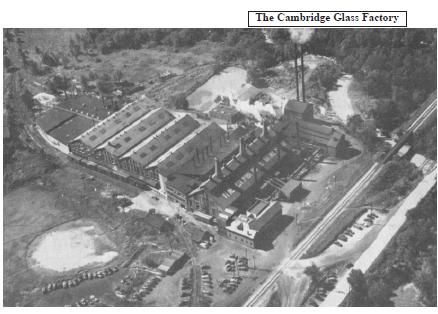1954: Cambridge Glass Company Sold
Contributed by George Fogg
Issue No. 426 - March 2009
From: The American Flint. Official Magazine of the American Flint Glass Workers' Union of North America. Volume XXXXIII, No. 10, September 1954, Toledo, Ohio. pp.4-5
The Cambridge Glass Company located in Cambridge, Ohio, one of the leading producers of fine Handmade Blown and Pressed Glassware, has been sold to Akron industrialist, Sidney L. Albert, according to a recent announcement received by the International Office of the union. It is our understanding that Mr. Albert is the owner of 26 other factories, but that the plant at Cambridge is his first venture into the glassware field.
The origin of the present company, as old timers of the industry
will recall, was tied in with the National Glass Company, an all
embracing combination of glassware factories that existed for a
 brief time at the turn of the century. The only new factory erected
by the company was the present plant at Cambridge.
brief time at the turn of the century. The only new factory erected
by the company was the present plant at Cambridge.
The Cambridge Glass Company was incorporated in 1901 as an operating corporation for National Glass. The late Arthur J. Bennett was called from New York to guide its destinies as president. Early in 1902, the first piece of glassware was produced in the new plant. It was a jug or pitcher and was gold encrusted. It was to be an appropriate forerunner of the beautiful glassware that the company was to turn out in the years that followed.
Arthur Bennett was not a glass manufacturer by training or by experience. He had been a buyer and importer of china and glass. He soon, however, proved his ability in the production field. Aided by many of the finest glass workers in the world, the company made rapid strides until the panic of 1907 which resulted in financial difficulties for National Glass. It eventually went into bankruptcy. For three years the position and future of the Cambridge Glass factory was uncertain.
Courageously, Mr. Bennett continued operations with the future of the plant always in doubt, but the operating company, of which he was the head, carried on. In the scrambled financial struggle of the National Glass Company it appeared at one time that the Cambridge Glass Company would lose its factory. Bennett went to Byesville, Ohio, three miles from Cambridge, and with the assistance of the townspeople got control of a small plant there. It was a far cry from the then new plant at Cambridge, but here at least the company was safe from the financial alarms surrounding the dying days of the National Glass Company.
After a long drawn out fight with the receivers and bond holders of the National Glass Company, an arrangement was made whereby Mr. Bennett purchased the factory and its equipment.
When the first piece of ware was produced in 1902, the entire production capacity of the plant was wrapped up in one fourteen pot furnace. The plant, however, continued to grow and prosper until, in the years that followed, three furnaces were in operation. During the years of World War II and those that immediately followed more than 600 workers, all members of the American Flint Glass Workers' Union, were employed there. The beautiful high quality handmade table and art glassware, vases, candelabra, plain, deep etched or gold encrusted, was sold in leading glassware markets. Today they beautify many an American home.
The courage Arthur J. Bennett demonstrated during the early days of the Cambridge Glass Company was to be reflected in the beauty of Cambridge glass. A large factor in the present Cambridge situation which led to the sale of the company was competition from low wage countries abroad, which has taken over a large share of the domestic market. The union and the industry have fought long and hard for protection, and only recently were notified that their petition for needed relief was denied by President Eisenhower.
As this report is made to the trade, the fires have been turned out in the furnaces. It is hoped, however, that the Sidney L. Albert Company will put forth every effort to operate the plant and maintain the traditions of the company's founder. In addition to fine glassware, the plant in the city of Cambridge has produced a long line of fine trade unionists. Their names and deeds are written in the proud history of the American Flint Glass Workers' Union of North America. Present Flint locals functioning in Cambridge are Local Union No. 74, embracing the Hot Metal and Cutting Departments, Local Union No. 89, composed of mould makers and machinists and Local Union No. 502, Miscellaneous Division employees.
